Boston Brahmin
The Boston Brahmins or Boston elite are members of Boston's traditional upper class.[1] They are often associated with a cultivated New England or Mid-Atlantic dialect and accent,[2] Harvard University,[3] Anglicanism,[4] and traditional British American customs and clothing. Descendants of the earliest English colonists are typically considered to be the most representative of the Boston Brahmins.[5][6] They are considered White Anglo-Saxon Protestants (WASPs).[7][8][9]
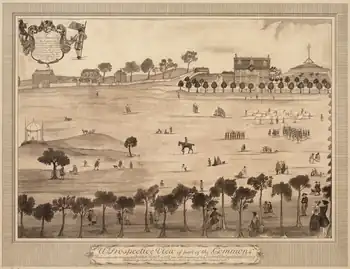
Etymology
The phrase "Brahmin Caste of New England" was first coined by Oliver Wendell Holmes Sr., a physician and writer, in an 1860 article in The Atlantic Monthly.[10] The term Brahmin refers to the priestly caste within the four castes in the Hindu caste system. By extension, it was applied in the United States to the old wealthy New England families of British Protestant origin that became influential in the development of American institutions and culture. The influence of the old American gentry has been reduced in modern times, but some vestiges remain, primarily in the institutions and the ideals that they championed in their heyday.[11]
Characteristics
.jpg.webp)
The nature of the Brahmins is referenced in the doggerel "Boston Toast" by Holy Cross alumnus John Collins Bossidy:
Many 19th-century Brahmin families of large fortune were of common origin; fewer were of an aristocratic origin. The new families were often the first to seek, in typically British fashion, suitable marriage alliances with those old aristocratic New England families that were descended from landowners in England to elevate and cement their social standing. The Winthrops, Dudleys, Saltonstalls, Winslows, and Lymans (descended from English magistrates, gentry, and aristocracy) were, by and large, happy with this arrangement. All of Boston's "Brahmin elite", therefore, maintained the received culture of the old English gentry, including cultivating the personal excellence that they imagined maintained the distinction between gentlemen and freemen, and between ladies and women. They saw it as their duty to maintain what they defined as high standards of excellence, duty, and restraint. Cultivated, urbane, and dignified, a Boston Brahmin was supposed to be the very essence of enlightened aristocracy.[15][16] The ideal Brahmin was not only wealthy, but displayed what was considered suitable personal virtues and character traits.
The Brahmin was expected to maintain the customary English reserve in his dress, manner, and deportment, cultivate the arts, support charities such as hospitals and colleges, and assume the role of community leader.[17]: 14 Although the ideal called on him to transcend commonplace business values, in practice many found the thrill of economic success quite attractive. The Brahmins warned each other against avarice and insisted upon personal responsibility. Scandal and divorce were unacceptable. This culture was buttressed by the strong extended family ties present in Boston society. Young men attended the same prep schools, colleges, and private clubs,[18] and heirs married heiresses. Family not only served as an economic asset, but also as a means of moral restraint.
Most belonged to the Unitarian or Episcopal churches,[19] although some were Congregationalists or Methodists.[20] Politically, they were successively Federalists, Whigs, and Republicans. They were marked by their manners and once distinctive elocution. Their distinctive Anglo-American manner of dress has been much imitated and is the foundation of the style now informally known as preppy. Many of the Brahmin families trace their ancestry back to the original 17th- and 18th-century colonial ruling class consisting of Massachusetts governors and magistrates, Harvard presidents, distinguished clergy, and fellows of the Royal Society of London (a leading scientific body), while others entered New England aristocratic society during the 19th century with their profits from commerce and trade, often marrying into established Brahmin families.[21]
List of families
Selected Boston Brahmins |
 |
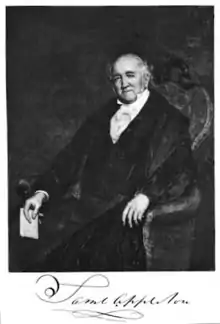 Samuel Appleton, American merchant |
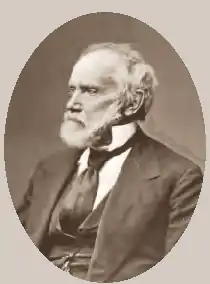 John Amory Lowell, banking merchant |
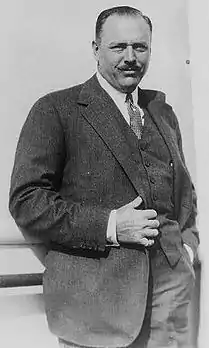 Robert L. Bacon, U.S. Congressman and attorney |
 Benjamin Bates, philanthropist, business magnate, and namesake of Bates College |
.jpg.webp) William Alfred Buckingham, American politician, Connecticut governor, and U.S. senator |
.jpg.webp) William Gardner Choate, federal judge and founder of Choate Rosemary Hall |
 John Coolidge, railroad executive and son of U.S. President Calvin Coolidge |
 Samuel Cooper, Congregational minister |
 Benjamin Williams Crowninshield, colonist |
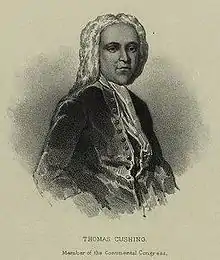 Thomas Cushing, Massachusetts colonial speaker of the house |
 Joseph Dudley, Royal Governor of Massachusetts |
.jpg.webp) William Emerson, Massachusetts minister |
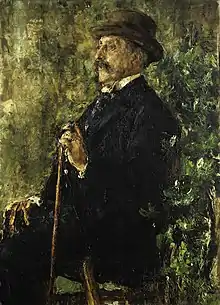 John Lowell Gardner, American businessman and art collector |
 Patrick Tracy Jackson, Boston manufacturer |
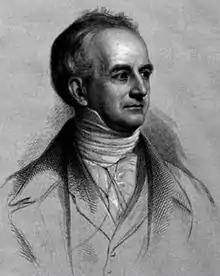 Abbott Lawrence, politician and founder of Lawrence, Massachusetts |
 Henry Cabot Lodge, American statesmen and congressman |
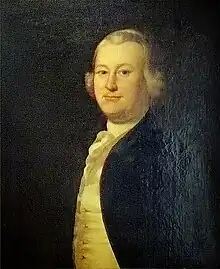 James Otis, colonial lawyer |
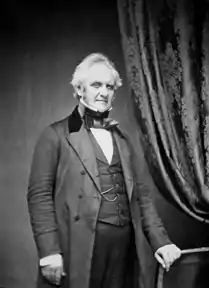 George Peabody, entrepreneur, philanthropist, and founder of the House of Morgan and the Peabody Institute |
 Charles C. Perkins, art historian, philanthropist, and founder of the Museum of Fine Arts |
 John Phillips, educator and founder of Phillips Exeter Academy |
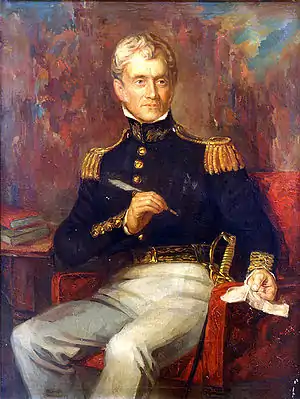 Sylvanus Thayer, the father of West Point |
 John G. Palfrey I, leader in founding Harvard Divinity School, U.S. Congressman, and Unitarian minister |
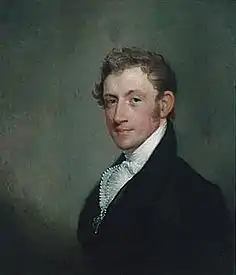 David Sears, businessman and philanthropist |
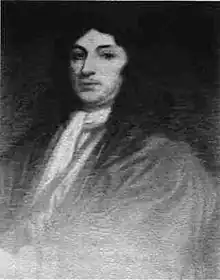 Thomas Dudley, first Massachusetts Bay Colony governor |
 Joseph Warren, Major general and physician |
Adams
- Samuel Adams (1722–1803), Founding Father; second cousin of:
- John Adams (1735–1826), Founding Father and second President of the United States; husband of Abigail Smith Adams (1744–1818)
- John Quincy Adams (1767–1848), sixth President of the United States
- Charles Francis Adams Sr. (1807–1886), Ambassador, U.S. congressman
- Charles Francis Adams Jr. (1835–1915), Civil War general
- John Quincy Adams II (1833–1894), lawyer, politician
- Charles Francis Adams III (1866–1954), U.S. Secretary of the Navy
- Charles Francis Adams IV (1910–1999), industrialist, first president of Raytheon
- Timothy Adams, son of Charles Francis Adams IV
- Charles Francis Adams IV (1910–1999), industrialist, first president of Raytheon
- Charles Francis Adams III (1866–1954), U.S. Secretary of the Navy
- Henry Brooks Adams (1838–1918), author
- Brooks Adams (1848–1927), historian
- Charles Francis Adams Sr. (1807–1886), Ambassador, U.S. congressman
- John Quincy Adams (1767–1848), sixth President of the United States
- Ivers Whitney Adams (1838–1914), founder of the oldest continuously playing professional baseball team, the Boston Red Stockings
Amory
- John Amory Lowell (1798–1881), merchant.
- Thomas Coffin Amory (1812–1889), lawyer, author.
- Thomas Jonathan Coffin Amory (1828–1864), Civil War general.
- Ernest Amory Codman (1869–1940), surgeon.
- Cleveland Amory (1917–1998), author.
Appleton
Patrilineal line:[22]
- Daniel Appleton (1785–1849), publisher.
- Frances Appleton (died 1861), wife of Henry Wadsworth Longfellow.
- George Swett Appleton (1821–1878), publisher.
- Jane Means Appleton Pierce (1806–1863), wife of U.S. President Franklin Pierce, was First Lady of the United States from 1853 to 1857.
- Jesse Appleton (1772–1819), second president of Bowdoin College
- John Appleton (1816–1864), assistant Secretary of State, diplomat, U.S. congressman.
- John Appleton (judge) (1804-1891), Chief Justice of the Maine Supreme Judicial Court.
- John F. Appleton (1838–1870), lawyer and Union colonel in the American Civil War.
- John James Appleton (1789–1864), ambassador.
- Nathan Appleton (1771–1861), U.S. congressman and merchant.
- Nathaniel Appleton (1693–1784), Congregational minister.
- Samuel Appleton (1625–1696), military and government leader in the Massachusetts Bay Colony and Province of Massachusetts Bay.
- Samuel Appleton (1766–1853), merchant and philanthropist.
- Thomas Gold Appleton (1812–1884), writer and art patron.
- William Appleton (1786–1862), U.S. congressman.
- William Henry Appleton (1814–1899), publisher.
- William Sumner Appleton (1874–1947), philanthropist.
Other notable relatives:[23][24][25]
- Thomas Storrow Brown (1803–1888), journalist, writer, orator, and revolutionary in Lower Canada (present-day Quebec)
- Edward Augustus Holyoke (1728–1829), educator and physician
- Alice Mary Longfellow (1850–1928), philanthropist and preservationist
- Ernest Wadsworth Longfellow (1845–1921), artist
- Alpheus Spring Packard (1839–1905), entomologist and paleontologist
- William Alfred Packard (1830–1909), classical scholar
- Charles Storrow Williams (1827–1890), railroad executive
- Edward H. Williams (1824–1899), physician and railroad executive
Bacon
- Robert Bacon (1860–1919), U.S. Secretary of State; father of
- Robert L. Bacon (1884–1938), member of the U.S. House of Representatives from New York
- Gaspar G. Bacon (1886–1947), politician; father of
- Gaspar G. Bacon Jr. (1914–1943), actor
Bates
Originally from Boston and Britain:
- Benjamin Bates I (c. 1651–1710), merchant banker, family patriarch
- Benjamin Bates II (1716 – c. 1820), member of the Hell Fire Club
- Frederick Bates (1777–1825), politician
- James Woodson Bates (1788–1846), judge
- Joshua Bates (financier), Barings Bank partner, managed many Brahmin family fortunes, advised Adams family on Court protocol
- Edward Bates (1793–1869), U.S. Attorney General
- Benjamin Bates IV (1808–1878), philanthropist, namesake and benefactor of Bates College
Boylston
Boylston Family
- Thomas Boylston (1644–1695), doctor, family patriarch
- Zabdiel Boylston (1679–1766), physician
- Ward Nicholas Boylston (1747–1828), benefactor, Harvard University
Bradlee
Bradlee Family
- Nathan Bradley I, earliest known member born in America, in Dorchester, Boston, Massachusetts, in 1631
- Samuel Bradlee, constable of Dorchester, Massachusetts
- Nathaniel Bradlee, Boston Tea Party participant, member of Massachusetts Charitable Mechanic Association
- Josiah Bradlee I, Boston Tea Party participant; m. Hannah Putnam
- Josiah Bradlee III (Harvard), m. Alice Crowninshield
- Frederick Josiah Bradlee I (Harvard), Director of the Boston Bank
- Frederick Josiah Bradlee Jr. (Harvard, 1915), on the first All-American football team at Harvard; m. Josephine de Gersdorff
- Frederick Josiah Bradlee III, Broadway actor, author
- Benjamin Crowninshield Bradlee (1921–2014) (Harvard, 1942), Chief Executive Editor of The Washington Post
- Ben Bradlee Jr. (born 1948), journalist and writer
- Frederick Josiah Bradlee Jr. (Harvard, 1915), on the first All-American football team at Harvard; m. Josephine de Gersdorff
- Joseph Putnam Bradlee (1783–1838), Commander of the New England Guards, chairman of the State Central Committee, Director and then President of the Boston City Council
- Samuel Bradlee Jr., lieutenant colonel during the American Revolutionary War
- Thomas Bradlee, Boston Tea Party participant; member of Massachusetts Charitable Mechanics Association; Member of the St. Andrews Lodge of Freemasons
- David Bradlee, Boston Tea Party participant; Captain in the Continental Army, member of the St. Andrews Lodge of Freemasons
- Sarah Bradlee, "Mother of the Boston Tea Party"
Brinley
Brinley Family of Boston, Newport, and Shelter Island, NY
- Francis Brinley, Esq. (1632–1719), arrived from England in 1651 after the English Civil War, with his two sisters, children of Thomas Brinley, auditor to King Charles I&II, his original home became Newport's White Horse Tavern, Judge, book collector, landowner (RI, MA, NJ), Governor's assistant, m: Hannah Carr (niece of RI Gov. Caleb Carr). Boston estate at Hanover and Elm, current site of Government Center.
- William Brinley, Esq. (1656–1704), first son of Francis, Judge in Newport, co-founder of Trinity Church, Newport, first Anglican church in RI, disinherited by father after marriage
- William Brinley, Esq. (1677–1753), only child of Wm. Brinley, Judge in Monmouth, NJ, passed over for younger cousin Francis Brinley
- John Brinley (1713–1775), Brinley grist mill owner in Oakhurst, NJ
- William Brinley (1754–1840), Major in Revolutionary War
- Sylvester C. Brinley (1816–1905), founded Brinley, Ohio (a.k.a. Brinley Station) in 1855.
- William Brinley (1754–1840), Major in Revolutionary War
- John Brinley (1713–1775), Brinley grist mill owner in Oakhurst, NJ
- William Brinley, Esq. (1677–1753), only child of Wm. Brinley, Judge in Monmouth, NJ, passed over for younger cousin Francis Brinley
- Thomas Brinley (1661–1693), second son of Francis, Boston/London merchant, co-founder of King's Chapel, Boston, first Anglican church in colonial New England.
- Eliakim Hutchinson (1711–1775), Judge, Chief Justice of the Court of Common Pleas for Suffolk County, and one of Boston's richest men, owner of Shirley Place (now Shirley-Eustis House) m:Elizabeth Shirley (daughter of MA Gov William Shirley)
- Colonel Francis Brinley[29] (1690–1765): Colonel in Ancient & Honorable Artillery Company, merchant, landowner (Datchet House/Brinley Place-Roxbury, Brinley Place-Framingham), one of the richest Bostonians of the 18th century, grandfather's heir, m: Deborah Lyde, granddaughter of Judge Nathaniel Byfield
- Francis Brinley Fogg Sr. Esq. (1795–1880), m. Mary Middleton Rutledge of Middleton Place, TN state senator, started Nashville public schools, school board president, namesake Fogg School opened in 1875, a founder of Sewanee University of the South. and Christ Church Cathedral Nashville
- Catherine Grace Frances Moody Nevinson Gore (1798–1861), English writer
- Francis William Brinley (1796–1859), merchant, mayor of Perth Amboy, NJ, Surveyor of NJ state.
- Francis Brinley Jr., Esq. (1800–1880), Harvard 1818-Porcellian Club, President of Boston Common Council, MA state legislator (House and Senate), clerk to Secretary of State, Daniel Webster, delegate to state constitutional convention, commander of the Ancient and Honorable Artillery Company.
- Edward Brinley (1809–1868), Importer for Edward Brinley & Co., Old Faneuil Hall, Boston
- George Brinley (1817–1875), noted book collector, pioneer of the Americanist movement
- Emily Malbone Morgan (1862–1939), founder of the Colonel Daniel Putnam Association and the Society of the Companions of the Holy Cross
- Godfrey Malbone Brinley (1864–1939), top 10 US tennis pro, later master at St. Paul's school
- Edward Brinley Faneuil Adams (1871–1922), Harvard 1892/Law 1897, Harvard Law librarian
- Daniel Putnam Brinley (1873–1963), artist (painter, muralist, impressionist)
- Charles Henry Brinley Esq (1825–1907), Judge in AZ, involved in early CA/AZ politics, int'l merchant, appointed Vice Consul to Mexico by Pres Theo. Roosevelt
- Charles Brinley (1880–1946), silent actor
- Emily Borie Ryerson (1863–1939), Titanic survivor, suffragette, philanthropist
- William Brinley, Esq. (1656–1704), first son of Francis, Judge in Newport, co-founder of Trinity Church, Newport, first Anglican church in RI, disinherited by father after marriage
- Anne Brinley Coddington (1628–1708), third wife of Governor William Coddington, who arrived with the Winthrop fleet in 1630 and became an early MA magistrate, the first Governor of Rhode Island/founder of Portsmouth and Newport, RI, and mother and grandmother of subsequent Governors.
- William Coddington Jr.(1651–1689), colonial Governor of Rhode Island
- Mary Coddington (1654–1693), wife of Gov. Peleg Sanford of RI
- William Coddington III (1680–1755), colonial Governor of Rhode Island, merchant, judge, m: Content Arnold
- Margaret Sanford Hutchinson (1716–1754), wife of Thomas Hutchinson (governor), last loyalist Gov. of MA
- Lucretia Rudolph Garfield (1832–1918), First Lady, wife of 20th U.S. President James A. Garfield
- Ted Danson (born 1947), actor, activist
- Grisell Brinley Sylvester (1635–1687), wife of Nathaniel Sylvester, together they became the first white settlers and owners of all of Shelter Island, NY. She is credited with bringing boxwoods to the colonies.
- Brinley Sylvester (1690–1752), built Sylvester Manor on Shelter Island, which was made a non-profit educational farm by the 11th generation heir.
- Charles Ward Apthorp Jr. (1729–1797), owner of Manhattan's Apthorp Farm, merchant, NY Governor's Council 1763-83
- Sarah Wentworth Apthorp Morton (1759–1846), poet, wife of Perez Morton, MA Speaker and AG.
- Charles Bulfinch (1763–1844), Harvard 1781/4, architect in Boston and of the US Capitol building
- Sen. James Lloyd (1769–1831), Harvard 1787/90, US Senator from MA, merchant, businessman
- Franklin Delano Roosevelt (1882–1945), Harvard 1904, 32nd and longest serving President of the United States
- Benjamin Crowninshield Bradlee (1921–2014), Harvard 1942, Executive Editor of The Washington Post
Buckingham
Originally from Boston and Britain:
- William Alfred Buckingham (1804–1875), Governor of Connecticut, U.S. senator.
- Edgar Buckingham, Harvard scholar creator of the Buckingham π theorem, a key theorem in dimensional analysis.
Cabot
Chaffee/Chafee
Originally of Hingham, Massachusetts:[30]
- Thomas Chaffee (1610–1683), businessman and landowner
- Jonathon Chaffee (1678–1766), businessman and landowner
- Matthew Chaffee (1657–1723), Boston landowner
- Adna Romanza Chaffee (1842–1914), U.S. general
- Adna R. Chaffee Jr. (1884–1941), U.S. general
- Zechariah Chafee (1885–1957), philosopher, civil libertarian
- John Chafee (1922–1999), U.S. senator
- Lincoln Chafee (born 1953), former U.S. senator, former Rhode Island governor, 2016 U.S. presidential candidate for the Democratic party
Choate
- Rufus Choate (1799–1859), U.S. senator
- George C. S. Choate (1827–1896), founder of Choate Sanitarium, Pleasantville, New York
- Joseph Hodges Choate (1832–1917), lawyer, diplomat
- William Gardner Choate (1830–1920), U.S. federal judge, founder of Choate Rosemary Hall
- Sarah Choate Sears (1858–1935), art patron
- Robert B. Choate Jr. (1924–2009), businessman
- Elizabeth Choate Spykman (1896–1965), writer
- Nathaniel Choate (1899–1965), artist, sculptor
Coffin
Originally of Newbury and Nantucket:
- Tristram Coffin (1604–1681), colonist, original owner of Nantucket
- William Coffin (1699–1775), merchant, co-founder of Trinity Church
- Sir Isaac Coffin (1759–1839), naval officer
- Charles E. Coffin (1841–1912), industrialist, U.S. congressman
- Charles A. Coffin (1844–1926), industrialist, co-founder of General Electric
- Henry Coffin Nevins (1843–1892), industrialist
- John Coffin Jones Sr. (1750–1820), Speaker of the Massachusetts House of Representatives
- John Coffin Jones Jr. (1796–1861), U.S. Minister to Hawaii
- Thomas Coffin Amory (1812–1889), lawyer, author
- Thomas Jonathan Coffin Amory (1828–1864), Civil War general
- David Coffin (active 1980–present), folk musician
Coolidge
- John Calvin Coolidge Sr. (1845–1926), politician and businessman
- Calvin Coolidge (1872–1933), 30th President of the United States
- John Coolidge (1906–2000), businessman and railroad executive
- Calvin Coolidge (1872–1933), 30th President of the United States
- T. Jefferson Coolidge (1831–1920), Financier, industrialist, and civic leader
- Archibald Cary Coolidge (1866–1928), educator
- John Gardner Coolidge (1863–1936), U.S. ambassador
- Charles A. Coolidge (1844–1926), U.S. Army general
Cooper
- John Cooper (1609–1669), colonist
- Samuel Cooper (1725–1783), clergyman
- Samuel D. Cooper Jr. (1750–1824), revolutionary
- Samuel D. Cooper III (1778–1853), trade merchant
- Priscilla Cooper Tyler (1816–1889), First Lady of the United States
- Theodore Cooper (1839–1919), civil engineer
- Frederic Taber Cooper (1864–1937), writer
Crowninshield
- Johann Casper Richter von Kronenscheldt, colonist
- Jacob Crowninshield (1770–1808), U.S. congressman
- Arent S. Crowninshield (1843–1908), U.S. Navy admiral
- Caspar Crowninshield (1837–1897), Union Army colonel
- Benjamin William Crowninshield (1837–1892), Union Army colonel
- Frederic Crowninshield (1845–1918), first president of the National Society of Mural Painters
- Benjamin Williams Crowninshield (1772–1851), 5th U.S. Secretary of Navy
- Frank Crowninshield (1872–1947), creator and editor of Vanity Fair
- Bowdin Bradlee Crowninshield (1867–1948), American naval architect
Descendants by marriage:
- William Crowninshield Endicott (1826–1900), 5th U.S. Secretary of War
- Frederick Josiah Bradlee Jr. (1892–1970), on the first All-American football team (from Harvard)
- Benjamin Crowninshield Bradlee Sr. (1921–2014), Editor-in-chief of The Washington Post
- Benjamin Crowninshield Bradlee Jr. (born 1948), Editor for The Boston Globe
- Josiah Quinn Crowninshield Bradlee (born 1982), founder and CEO of FriendsOfQuinn.com
Cushing
Originally of Hingham, Massachusetts:[31]
- Caleb Cushing (1800–1879), U.S. congressman and Attorney General
- John Perkins Cushing (1787–1862), China trade merchant, investor
- Thomas Cushing (1725–1788), statesman, revolutionary
- William Cushing (1732–1810), U.S. Supreme Court justice
- Harvey Cushing (1869–1939), neurosurgeon
Descendant by marriage:
- Albert Cushing Read (1887–1967), naval officer
Dana
- Richard Dana (1699–1772), colonial Boston politician.
- Francis Dana (1743–1811), revolutionary.
- Richard Henry Dana Sr. (1787–1879), lawyer, author.
- Richard Henry Dana Jr. (1815–1882), lawyer, author (Two Years Before the Mast).
Delano
- Columbus Delano (1809–1896), U.S. Secretary of the Interior
- Jane Delano (1862–1919), founder of the American Red Cross Nursing Service
- Paul Delano (1745–1842), naval officer
- Franklin Delano Roosevelt (1882–1945), President of the United States
- Frederic A. Delano (1863–1953), civic reformer and railroad president
Dudley
Dudley Family
- Gov. Thomas Dudley (1576–1653), Governor of Massachusetts, a founder of Harvard College.
- Mercy Dudley; m. John Woodbridge (1613-1695)
- Martha Woodbridge; m. Samuel Ruggles (1659-1716)
- Rev. Timothy Ruggles (1695-1768); m. Mary White
- Timothy Ruggles
- Nathaniel Ruggles (1725 - ); m. Deliverance Barrow
- Rev. Timothy Ruggles (1695-1768); m. Mary White
- Martha Woodbridge; m. Samuel Ruggles (1659-1716)
- Mercy Dudley; m. John Woodbridge (1613-1695)
- Anne Dudley Bradstreet (1612–1672), first American poet, wife of Royal Governor Simon Bradstreet.
- Joseph Dudley (1647–1720), Royal Governor of Massachusetts, President of the Dominion of New England, Chief Justice of New York, Member of Parliament, Lt. Governor of the Isle of Wight.
- Paul Dudley (1675–1751), Chief Justice of Massachusetts, member of the Royal Society, founder of the Dudleian lectures at Harvard.
- Paul Dudley Sargent (1745–1828), Army colonel and Revolutionary War hero.
- Dudley Saltonstall (1738–1796), Naval commodore during the Revolution and successful privateer.
Dwight
- Timothy Dwight IV (1752–1817), president of Yale University.
- Joseph Dwight (1703–1765), lawyer, French and Indian War veteran.
- James Dwight Dana (1813–1895), geologist.
Eliot
- Samuel Eliot (banker) (1739–1820).
- Samuel Atkins Eliot (politician) (1798–1862).
- Charles William Eliot (1834–1926), president of Harvard University.
- Charles Eliot (1859–1897), landscape architect.
- Samuel A. Eliot II (1862–1950), president of the American Unitarian Association.
- Samuel Eliot Morison (1887–1976), maritime author.
- Theodore Lyman Eliot (1928–2019), diplomat.
- Charles Eliot Norton (1827–1908), author.
- T. S. Eliot (1888–1965), Nobel Prize-winning poet, playwright, and literary critic.
Emerson
- Rev. William Emerson (1769–1811), clergyman; m. Ruth Haskins Emerson.
- Ralph Waldo Emerson (1803–1882), poet; m. Lydia Jackson Emerson.
- Edward Waldo Emerson, (1844–1930).
- Raymond Emerson, (1886–1977).
- Edward Waldo Emerson, (1844–1930).
- Ralph Waldo Emerson (1803–1882), poet; m. Lydia Jackson Emerson.
Endicott
- William Crowninshield Endicott (1826–1900), U.S. Secretary of War.
- Augustus Bradford Endicott (1818–1910), politician.
- Philip Endicott Young (1885–1955), industrialist.
- Henry Bradford Endicott (1853–1920), industrialist.
- Henry Wendell Endicott (1880–1954), philanthropist.
Everett
Everett Family
- Richard Everett (1597–1682), early colonist and native of Holbrook, England. He was a founder of Springfield, Massachusetts, and progenitor of the American Everett family.
- Deac. John Everett (1676–1751), early deacon at the First Church and Parish in Dedham and member of the Massachusetts General Court.
- John Everett (1736–1799), numerous times elected as selectman for Norfolk County, Massachusetts (1770s–1790s) and member of the Massachusetts General Court (1780s–1790s).
- David Everett (1745–1775), revolutionary and killed defending Bunker Hill.
- Moses Everett (1750–1813), judge for Norfolk County, Massachusetts and member of the Massachusetts General Court.
- Rev. Oliver Everett (1752–1802), prominent Congregational minister and judge for Norfolk County, Massachusetts.
- Melatiah Everett (1777–1858), member of the Massachusetts Senate (1812, 1841).
- Horace Everett (1779–1851), member of the Vermont House of Representatives (1819–1820, 1822, 1824, 1834) and the United States House of Representatives from Vermont's 3rd congressional district (1829–1843).
- Ebenezer Everett (1788–1869), long-time Maine state official, trustee of Bowdoin College, member of the Maine Legislature (1840s).
- Alexander Hill Everett (1790–1847), American Ambassador to the Netherlands (1819–1824), Ambassador to Spain (1825), and Ambassador to the Qing Empire (1845–1847) .
- Edward Everett (1794–1865), statesman and diplomat. He was a member of the United States House of Representatives from Massachusetts's 4th congressional district (1825–1835), Governor of Massachusetts (1836–1840), Ambassador to Great Britain (1841–1845), President of Harvard University (1846–1848), the United States Secretary of State (1852–1853), and a United States Senator for Massachusetts (1853–1854).
- Horace Everett (1819–1890), a native of Windsor, Vermont, he was a prominent early founder of Council Bluffs, Iowa.
- Henry Sidney Everett (1834–1898), long-time diplomat, Secretary of the American Legation at Berlin (1877–1884).
- William Everett (1839–1910), member of the United States House of Representatives from Massachusetts's 7th congressional district (1893–1895).
- Sidney Brooks Everett (1868–1901), member of the Boston City Council (1892–1894), American Consul to the Dutch East Indies (appointed 1897), and secretary and chargé de affairs to the American Legation in Guatemala (1900–1901).
Descendants through the marriage of Sarah Preston Everett (1796–1866) and noted journalist Nathan Hale (1784–1863):
- Prof. Nathan Hale Jr. (1818–1871), journalist and professor at Union College.
- Lucretia Peabody Hale (1820–1900), author and journalist.
- Edward Everett Hale (1822–1909), famed author and Unitarian minister and theologian.
- Charles Hale (1831–1882), member and later Speaker of the Massachusetts House of Representatives (1855–1859), Consul-General to Egypt (1864–1870), and the United States Assistant Secretary of State (1872–1873).
- Susan Hale (1833–1910), artist and author.
- Ellen Day Hale (1855–1940), artist.
- Prof. Edward Everett Hale Jr. (1863–1932), distinguished and long-time professor at Union College.
- Philip Leslie Hale (1865–1931), artist.
- Nancy Hale (1908–1988), author.
Fabens
Of Marblehead and Salem:[32]
- William Fabens (1810–1883), lawyer, member of Assembly, Senate[32]
- William Chandler Fabens (1843–1903), Lynn attorney,[33] namesake of Fabens Building
- Samuel Augustus Fabens (1813–1899), master mariner in the East India and California trade[32]
- Francis Alfred Fabens (1814–1872), mercantile businessman, San Francisco judge, attorney[32]
- Joseph Warren Fabens (1821–1875), U.S. Consul at Cayenne, businessman, Envoy Extraordinary of the Dominican Republic[32]
- George Wilson Fabens (1857–1939), attorney, land commissioner and superintendent of Southern Pacific Railroad, namesake of Fabens, Texas[34]
Forbes
- John Murray Forbes (1813–1898), industrialist
- Edward W. Forbes (1873–1969), Director of the Fogg Art Museum at Harvard University from 1909 to 1944.
- John Forbes Kerry (born 1943), United States Secretary of State (2013–2017), senator from Massachusetts (1985–2013)
- Elliot Forbes (1917–2006), conductor and musicologist
- Robert Bennet Forbes (1804–1889), sea captain, China merchant, ship owner, writer
- William Howell Forbes (1837–1896), businessman
- Beatrice Forbes Manz, professor of history at Tufts University
Gardner
Originally of Essex county:
- Samuel Pickering Gardner (1767–1843),[35] merchant.
- John Lowell Gardner (1808–1884), merchant.
- John Lowell Gardner II (1837–1898), merchant.
- Augustus P. Gardner (1865–1918), U.S. congressman.
- Isabella Stewart Gardner (1840-1924), art collector, philanthropist, and patron of the arts.
Gillett
- Jonathan Gillett (1609–1677), colonist
- Edward Bates Gillett (1817–1899), attorney
- Frederick Huntington Gillett (1851–1935), 37th Speaker of the United States House of Representatives
- Arthur Lincoln Gillett (1859–1938), clergyman
- Ezra Hall Gillett (1823-1875), clergyman and author
- Charles Ripley Gillett (1855-1948), clergyman
Hallowell
- Ward Nicholas Boylston (1747–1828), merchant and philanthropist
- Norwood Penrose Hallowell (1839–1914), colonel in the 54th Massachusetts regiment
- Norwood Penrose Hallowell Jr. (1875-1961), President of Lee, Higginson & Co.
- Edward Needles Hallowell (1836–1871), An officer in the 54th Massachusetts. He and his brother were collectively portrayed by actor Cary Elwes in his role as Major Cabot Forbes in the Civil War movie Glory.
- John Hallowell (1878–1927), Harvard Football player and assistant to Herbert Hoover in the United States Food Administration during World War I
Healey/Dall
- Mark Healey (1791–1872), originally of New Hampshire, merchant and first president of the Merchant's Bank[36]
- Caroline Wells Healey (1822–1912), writer, feminist, and abolitionist
- Charles Henry Appleton Dall (1816–1886), first Unitarian minister to India
- William Healey Dall (1845–1912), malacologist, paleontologist, and explorer of Alaska
Holmes
- Abiel Holmes (1763–1837), clergyman
- Oliver Wendell Holmes Sr. (1809–1894), doctor, author
- Oliver Wendell Holmes Jr. (1841–1935), U.S. Supreme Court justice
- Oliver Wendell Holmes Sr. (1809–1894), doctor, author
Jackson
- Edward Jackson (1708–1757), colonist; m. Dorothy Quincy Jackson
- Jonathan Jackson (1743–1810), merchant, revolutionary; m. Hannah Tracy Jackson
- Charles Jackson (1775–1855), Massachusetts Supreme Court justice
- James Jackson (1777–1867), Physician m. Elizabeth Cabot
- Francis Henry Jackson (1815–1873), m. Sarah Ann Boott
- James Tracy Jackson (1843–1900), m. Rebecca Nelson Borland
- James Tracy Jackson Jr. (1881–1952), m. Rachel Brooks
- Francis Gardner Jackson (1914–1970), m. Jane Matthews
- Francis Gardner Jackson Jr. (born 1943), m. Pamela Graves Hardee
- Patrick Graves Jackson (born 1969), Surgeon, husband to Ketanji Brown Jackson[37] and related to Oliver Wendell Holmes Jr.
- Francis Gardner Jackson Jr. (born 1943), m. Pamela Graves Hardee
- Francis Gardner Jackson (1914–1970), m. Jane Matthews
- James Tracy Jackson Jr. (1881–1952), m. Rachel Brooks
- James Tracy Jackson (1843–1900), m. Rebecca Nelson Borland
- Amelia Lee Jackson: wife of Oliver Wendell Holmes Sr.
- Oliver Wendell Holmes Jr., Associate Justice of the Supreme Court of the United States
- Francis Henry Jackson (1815–1873), m. Sarah Ann Boott
- Patrick Tracy Jackson (1780–1847), co-founder of the Boston Manufacturing Company
- Hannah Jackson, wife of Francis Cabot Lowell
- Jonathan Jackson (1743–1810), merchant, revolutionary; m. Hannah Tracy Jackson
- Lydia Jackson, wife of Ralph Waldo Emerson
- Greling Jackson
Knowles
- Freeman Knowles (1846–1910)
- Horace G. Knowles (1863–1937)
- John Knowles (1926–2001)
- Malcolm Knowles (1913–1997)
- Tony Knowles (politician) (born 1943)
- Warren P. Knowles (1908–1993)
- William Standish Knowles (1917–2012)
Lawrence
- Samuel Lawrence (died 1827), revolutionary
- Amos Lawrence (1786–1852), merchant
- Amos Adams Lawrence (1814–1886), abolitionist
- William Lawrence (1850–1941), Episcopal bishop
- William Appleton Lawrence (1889–1963), Episcopal bishop
- Frederic C. Lawrence (1899–1989), Episcopal bishop
- William Lawrence (1850–1941), Episcopal bishop
- Amos Adams Lawrence (1814–1886), abolitionist
- Abbott Lawrence (1792–1855), U.S. congressman, founder of Lawrence, Massachusetts
- Luther Lawrence (died 1839), politician
- Amos Lawrence (1786–1852), merchant
Descendant by marriage: Abbott Lawrence Lowell (1856–1943), president of Harvard University
Lodge
- John Ellerton Lodge, husband of Anna Cabot
- Henry Cabot Lodge (1850–1924), U.S. senator
- George Cabot Lodge (1873–1909), poet
- Henry Cabot Lodge Jr. (1902–1985), U.S. senator, U.S. Ambassador to the United Nations
- George Cabot Lodge II (born 1927), Harvard Business School professor, 1962 U.S. Senate candidate from Massachusetts against Edward M. Kennedy
- Henry Sears Lodge (1930–2017)
- John Davis Lodge (1903–1985), 79th governor of Connecticut, U.S. ambassador
- Lily Lodge (1930-2021)
- Henry Cabot Lodge Jr. (1902–1985), U.S. senator, U.S. Ambassador to the United Nations
- George Cabot Lodge (1873–1909), poet
- Henry Cabot Lodge (1850–1924), U.S. senator
Lowell
- John Lowell (1743–1802), Member of the Continental Congress and Federal Judge
- John Lowell (1769–1840), lawyer and Federalist
- John Amory Lowell (1798–1881), industrialist, philanthropist
- John Lowell (1824–1897), Federal Judge
- John Lowell (1856–1922), lawyer
- Mary Emlen Lowell (1884–1975), Countess of Berkeley, m. Earl of Berkeley
- Ralph Lowell (1890–1978), philanthropist, founder of WGBH
- Olivia Lowell (1898–1977), m. Augustus Thorndike (1896–1986)
- James Lowell (1869–1933), Federal Judge
- John Lowell (1856–1922), lawyer
- Augustus Lowell (1830–1900), industrialist, philanthropist
- Percival Lowell (1855–1916), famous astronomer
- Abbott Lawrence Lowell (1856–1943), President of Harvard University, 1909–1933
- Elizabeth Lowell (1862–1935), m. William Lowell Putnam (see below)
- Katherine Putnam (1890–1983), m. Harvey Bundy (1888–1963)
- William Bundy (1917–2000), foreign affairs advisor to John F. Kennedy and Lyndon Johnson
- McGeorge Bundy (1919–1996), U.S. National Security Advisor
- Katharine Lawrence Bundy (1923–2014), m. Hugh Auchincloss Jr. (1915–1998), 1st cousin once removed of Hugh D. Auchincloss
- Hugh Auchincloss III (born 1949), m. Laurie Hollis Glimcher (born 1951), divorced; daughter of Melvin J. Glimcher
- Jake Auchincloss (born 1988), Captain in United States Marines, City of Newton, Massachusetts Councilman (2015–2020), United States Congressman for Massachusetts (2021-present)
- Hugh Auchincloss III (born 1949), m. Laurie Hollis Glimcher (born 1951), divorced; daughter of Melvin J. Glimcher
- Roger Putnam (1893–1972), Mayor of Springfield, Director of the Economic Stability Administration (ESA)
- Katherine Putnam (1890–1983), m. Harvey Bundy (1888–1963)
- Amy Lowell (1874–1925), Pulitzer Prize-winning poet
- John Lowell (1824–1897), Federal Judge
- John Amory Lowell (1798–1881), industrialist, philanthropist
- Francis Cabot Lowell (1775–1817), founder of the Industrial Revolution in the United States
- John Lowell Jr. (1799–1836), Founder of the Lowell Institute
- Francis Cabot Lowell Jr. (1803–1874), industrialist
- George Gardner Lowell (1830–1885)
- Francis Cabot Lowell (1855–1911), Federal Judge
- Edward Jackson Lowell (1845–1894), historian
- Guy Lowell (1870–1927), architect
- George Gardner Lowell (1830–1885)
- Rebecca Russell Lowell (1779–1853), m. Samuel Pickering Gardner (1767–1843)
- John Lowell Gardner (1804–1884)
- John Lowell Gardner (1837–1898), m. Isabella Stewart (1840–1924)
- John Lowell Gardner (1804–1884)
- Charles Lowell (1782–1861), Unitarian minister
- Charles Russell Lowell (1807–1870)
- Charles Russell Lowell Jr. (1835–1864), Civil War general, m. Josephine Shaw
- Harriet Lowell (1836–1920), m. George Putnam (1834–1917)
- William Lowell Putnam (1861–1923), lawyer and banker, m. Elizabeth Lowell (see above)
- Mary Traill Spence Lowell Putnam (1810–1898), author, translator
- Robert Traill Spence Lowell (1816–1891)
- Robert T.S. Lowell (1860–1887)
- Robert T.S. Lowell (1887–1950), naval officer
- Robert Lowell (1917–1977), Pulitzer Prize–winning poet
- Robert T.S. Lowell (1887–1950), naval officer
- Robert T.S. Lowell (1860–1887)
- James Russell Lowell (1819–1891), American Romantic poet, Ambassador to Spain and England
- Charles Russell Lowell (1807–1870)
- John Lowell (1769–1840), lawyer and Federalist
Lyman
- Theodore Lyman (1753–1839), China trade merchant, commissioned Samuel McIntire to build one of New England's finest country houses, The Vale
- Theodore Lyman II (1792–1849), brigadier general of militia, Massachusetts state representative, mayor of Boston
- Theodore Lyman III (1833–1897), natural scientist, aide-de-camp to Major General Meade during the American Civil War, and United States congressman from Massachusetts
- Theodore Lyman IV (1874–1954), director of Jefferson Physics Lab, Harvard. The Lyman series of spectral lines, the crater Lyman on the far side of the Moon, and the Lyman Physics Building at Harvard are named after him.
Minot
- Charles Sedgwick Minot (1852–1914), anatomist
- George Richards Minot (1885–1950), winner of the Nobel Prize in Medicine
- Henry Davis Minot (1859–1890), ornithologist
- Susan Minot (born 1956), author
- Alexandria Minot (born 1981), lawyer, human rights activist
Norcross
Original from Watertown, Massachusetts
- Otis Norcross (1811–1882), mayor of Boston
- Amasa Norcross (1824–1898), politician
- Eleanor Norcross (1854–1923), artist
Otis
- James Otis Jr. (1725–1783), revolutionary[38]
- Mercy Otis Warren (1728–1814), playwright, revolutionary
- Samuel Allyne Otis (1740–1814), politician
- Harrison Gray Otis (1765–1848), U.S. senator, mayor of Boston
Paine
- Robert Treat Paine (1731–1814), lawyer, politician, and a Founding Father of the United States who signed the Continental Association and the Declaration of Independence.
- Robert Treat Paine Jr. (1773–1811), a poet and editor
- Charles Jackson Paine (1833–1916), railroad executive, yachtsman, and general in the Union Army during the American Civil War.
- Robert Treat Paine (philanthropist) (1835–1910), lawyer, philanthropist, and social reformer
- Sumner Paine (1868–1904), American shooter who competed at the 1896 Summer Olympics.
- John Paine (sport shooter) (1870–1951), American shooter who competed at the 1896 Summer Olympics.
- Lyman Paine (1901–1978), architect and far-left activist.
- Robert Treat Paine Storer (1893–1962), All-American football player for Harvard University and decorated veteran of World War I.
- Robert T. Paine (zoologist) (1933–2016), the ecologist who coined the term "keystone species".
- Michael Paine (1928–2018), an acquaintance of Lee Harvey Oswald, unknown Paine and his wife Oswald had been hiding his Carcano Model 38 infantry carbine rifle in the garage of their Irving, Texas home, that was used to kill President John F. Kennedy, and wound Texas Governor John Connally in November 1963, and used beforehand in a failed attempt on the life of far-right activist, resigned Army General, Edwin Walker, in April of that year.
- Ruth Paine (1932–present) friend of Marina Oswald, who was living with her at the time of the assassination of President Kennedy.
Palfrey
- Peter Palfrey (1611–1663), one of the founders of Salem, Salem representative to the first General Court of Massachusetts Bay Colony[39]
- William Palfrey (1741–1780), American patriot, Aide-de-camp to George Washington, chief clerk to John Hancock, successful merchant[40]
- John G. Palfrey I (1796–1881), played a leading role in the creation of Harvard Divinity School, first Dean of Harvard Divinity School, U.S. Congressman from Massachusetts, Unitarian minister, historian[41]
- Francis Winthrop Palfrey (1831–1889), historian, decorated Union officer
- Sarah Palfrey Danzig (1912–1996), won 18 national tennis championship titles (singles, doubles, mixed doubles)
- John G. Palfrey V (1919–1979), member of President Kennedy's Atomic Energy Commission, Dean of Columbia University[42][43]
- John G. "Sean" Palfrey VI (born 1945), pediatrician and advocate, Harvard Faculty Dean of Adams House with Judy Palfrey[44]
- John G. Palfrey VII (born 1972), educator and author, historian, Headmaster of Phillips Academy[45]
Parkman
Parkman Family
- Samuel Parkman (1751–1824), investor; father of
- George Parkman, physician, investor, philanthropist; victim in the Parkman–Webster murder case
- Francis Parkman Jr., historian; grandson of Samuel Parkman; nephew of George Parkman
Peabody
- Elizabeth Palmer Peabody (1804–1894), American educator who opened the first English-language kindergarten in the United States
- Endicott Peabody (1857–1944), Episcopal priest, founder of the Groton School for Boys
- Endicott "Chubb" Peabody (1920–1997), governor of Massachusetts
- George Peabody (1795–1869), entrepreneur, philanthropist who founded the House of Morgan[46] and the Peabody Institute
- Joseph Peabody (1757–1844), merchant, shipowner, philanthropist whose company sailed clipper ships in the Old China Trade from its base in Salem, Massachusetts
- Mary Tyler Peabody Mann (1806–1887), American author
- Nathaniel Peabody (1774–1855)
- Richard R. Peabody (1892–1936), author of The Common Sense of Drinking, a major influence on Alcoholics Anonymous founder Bill Wilson
- Sophia Amelia Peabody Hawthorne (1809–1871), painter, illustrator, wife of American author Nathaniel Hawthorne
Perkins
- Thomas Handasyd Perkins (1764–1854), merchant, pioneer of the China trade, philanthropist
- Charles Perkins (1823–1886), art historian, philanthropist, founder of the Museum of Fine Arts
- Edward Perkins (1856–1905), constitutional lawyer
- Maxwell Perkins (1884–1947), literary editor of Ernest Hemingway, William Faulkner, and F. Scott Fitzgerald
Phillips
- Rev. George Phillips (1593–1644), gateway ancestor to the Phillips New England family, one of the founders of Watertown, Massachusetts
- Christopher H. Phillips (1920–2008), politician, diplomat
- Samuel Phillips Jr. (1752–1802), politician, founder of Phillips Academy
- John Phillips (1719–1795), educator, founder of Phillips Exeter Academy
- John Sanborn Phillips (1861–1949), publisher of McClure's Magazine
- Wendell Phillips (1811–1884), abolitionist
- William Phillips (1878–1968), diplomat
- Samuel Phillips (1690–1771), first pastor of the South Church of Andover
Other notable relatives:
- Phillips Brooks (1835–1893), American Episcopal clergyman and author
- Samuel Phillips Huntington (1927–2008), Harvard University political science professor and author; grandson of John Sanborn Phillips
- Charles F. Brush (1849–1929), inventor, philanthropist
- Bill Gates (born 1955), billionaire software pioneer, philanthropist, investor, entrepreneur
Putnam
- James Putnam (1725–1789), last attorney general in Massachusetts before American Revolution; judge and politician in New Brunswick
- James Putnam (1756–1838), Canadian politician
- Major General Israel Putnam (1718–1790), U.S. general during the Revolutionary War
- Colonel Daniel Putnam (1759–1831), colonel in U.S. Continental Army; his home is Putnam Elms
- John Day Putnam (1837–1904), Wisconsin politician
- Colonel Daniel Putnam (1759–1831), colonel in U.S. Continental Army; his home is Putnam Elms
- William Lowell Putnam (1861–1924), and Elizabeth Lowell Putnam
- George P. Putnam (1887–1950), publisher, explorer, husband of Amelia Earhart
- Katherine L. Putnam (1890–1983), wife of Harvey Hollister Bundy
- Roger Lowell Putnam (1893–1972), politician, businessman
Quincy
- Edmund Quincy (1602–1636), settled in Massachusetts Bay Colony in 1633
- Josiah Quincy II (1744–1775), lawyer, revolutionary
- Josiah Quincy III (1772–1864), member of the U.S. House of Representatives from Massachusetts, mayor of Boston, president of Harvard University
- Dorothy Quincy Hancock, wife of John Hancock
- Abigail Smith Adams (1744–1818), wife of John Adams
- John Quincy Adams (1767–1848), President of the United States
Rice
Originally of Sudbury, Massachusetts:
- Deacon Edmund Rice (1594–1663), colonist
- Alexander Hamilton Rice (1818–1895), industrialist, mayor of Boston, governor of Massachusetts, member of the U.S. House of Representatives from Massachusetts
- Alexander Hamilton Rice Jr. (1875–1956), physician, geographer, explorer
- Brigadier General Americus Vespucius Rice (1835–1904), U.S. general, member of the U.S. House of Representatives from Ohio, banker
- Brigadier General Edmund Rice (1842–1906), U.S. general, Medal of Honor recipient
- Edmund Rice (1819–1889), U.S. senator, member of the U.S. House of Representatives from Minnesota
- Henry Mower Rice (1816–1894), U.S. senator
- Luther Rice (1783–1836), Baptist clergyman, missionary to India
- Thomas Rice (1768–1854), member of the U.S. House of Representatives from Massachusetts
- William Marsh Rice (1816–1900), businessman, founder of Rice University
- William North Rice (1845–1928), geologist, educator
- William Whitney Rice (1826–1896), member of the U.S. House of Representatives from Massachusetts
- William B. Rice (1840–1909), industrialist, philanthropist
Saltonstall
- Leverett Saltonstall I (1783–1845), politician, educator[47]
- Leverett Saltonstall (1892–1979), U.S. senator
- William L. Saltonstall (1927–2009), politician
- Elizabeth Saltonstall (1900–1990), lithographer, painter
- Philip Saltonstall Weld (1915–1984), World War II commando, environmentalist
- William G. Saltonstall (1905–1989), 8th Principal of Phillips Exeter Academy
Sargent
- Colonel Epes Sargent (1690–1762), colonel of militia before the Revolution and a justice of the general session court for more than 30 years
- Paul Dudley Sargent (1745–1828), Revolutionary officer, one of the founding overseers of Bowdoin College
- Harrison Tweed (1885–1969), lawyer, civic leader
- Tweed Roosevelt (born 1942), great-grandson of President Theodore Roosevelt
- Harrison Tweed (1885–1969), lawyer, civic leader
- John Sargent (1750–1824), Loyalist officer during the American Revolution
- Winthrop Sargent (1753–1820), patriot, governor, politician, writer; member of the Federalist Party
- Judith Sargent Murray (1751–1820), feminist, essayist, playwright, poet; her home is the Sargent House Museum
- Daniel Sargent Sr. (1730–1806), merchant, owned Sargent's Wharf in Boston
- Daniel Sargent (1764–1842), merchant, politician
- Daniel Sargent Curtis (1825–1908), lawyer, banker, trustee of the BPL, owner of Palazzo Barbaro
- Henry Sargent (1770–1845), painter, military man
- Henry Winthrop Sargent (1810–1882), horticulturist, landscape gardener
- Ignatius Sargent Sr. (1765–1821), merchant, military man
- Ignatius Sargent (1800–1884), banker, railroad executive, horticulturalist, landscape gardener
- Charles Sprague Sargent (1841–1927), botanist, first director of Harvard University's Arnold Arboretum
- Ignatius Sargent (1800–1884), banker, railroad executive, horticulturalist, landscape gardener
- Lucius Manlius Sargent (1786–1867), author, antiquarian, temperance advocate
- Brigadier General Horace Binney Sargent (1821–1908), U.S. Civil War general (Union Army), politician
- John Singer Sargent (1856–1925), artist, considered the "leading portrait painter of his generation"
- Winthrop Sargent Gilman (1808–1884), head of the banking house of Gilman, Son & Co. in New York City
- Epes Sargent (1813–1880), editor, poet, playwright
- Francis W. Sargent (1915–1998), 64th governor of Massachusetts
- Benjamin Crowninshield Bradlee (1921–2014), (Harvard, 1942): editor of The Washington Post
- Frances Sargent Osgood (1811–1850), poet, one of the most popular women writers during her time
- Anna Maria Wells (née Foster; c. 1794–1868), early American poet, children's author
- Daniel Sargent (1764–1842), merchant, politician
- Paul Dudley Sargent (1745–1828), Revolutionary officer, one of the founding overseers of Bowdoin College
Sears
- Richard Sears (1610–1676), colonist
- David Sears II (1787–1871), philanthropist, merchant, landowner
- Clara Endicott Sears (1863–1960), author, philanthropist
- Mason Sears (1899–1973), politician, ambassador
- Emily Sears, wife of Henry Cabot Lodge Jr.
- John W. Sears (1930–2014), politician
Sedgwick
- Major General Robert Sedgwick (1611–1656), immigrant, Commander of the Massachusetts Bay Colony forces
- Hon. Theodore Sedgwick (1746–1813), 4th Speaker of the U.S. House of Representatives; major in U.S. Continental Army
- Major General John Sedgwick (1813–1864), U.S. Civil War general (Union Army)
- Theodore Sedgwick Jr. (1780–1839), lawyer, author; politician
- Theodore Sedgwick III (1811–1859), attorney, legal author, U.S. Minister to France
- Catharine Maria Sedgwick (1789–1876), one of the first noted female writers in the United States
- Henry Dwight Sedgwick (1785–1831), father of
- Henry Dwight Sedgwick II (1824–1903), father of
- Ellery Sedgwick (1872–1960), magazine editor; father of
- Ellery Sedgwick Jr. (1908–1991), father of
- Theodore “Tod” Sedgwick, diplomat, publisher
- Ellery Sedgwick Jr. (1908–1991), father of
- Henry Dwight Sedgwick III (1861–1957), lawyer, author; father of
- Henry Dwight Sedgwick IV (1896–1914)
- Francis Minturn Sedgwick (1904–1967), father of
- Edith Minturn Sedgwick (1943–1971), American socialite, actress, fashion model who worked with Andy Warhol
- Robert Minturn Sedgwick (1899–1976), father of
- Henry Dwight Sedgwick V (1928–2018), venture capitalist; husband of Helen Stern (1930–2019) and Patricia Rosenwald Sedgwick (born 1933); father of
- Mike Stern (born Michael Sedgwick 1953), jazz guitarist
- Kyra Minturn Sedgwick (born 1965), actress, producer, director; wife of Kevin Bacon; mother of
- Sosie Bacon (born 1992), actress
- Holly Sedgwick (born c. 1955), mother of
- Justin Nozuka (born 1988)
- George Nozuka (born 1986)
- Philip Nozuka (born 1987)
- Robert Sedgwick (born c. 1951)
- Henry Dwight Sedgwick V (1928–2018), venture capitalist; husband of Helen Stern (1930–2019) and Patricia Rosenwald Sedgwick (born 1933); father of
- Ellery Sedgwick (1872–1960), magazine editor; father of
- Henry Dwight Sedgwick II (1824–1903), father of
- Hon. Theodore Sedgwick (1746–1813), 4th Speaker of the U.S. House of Representatives; major in U.S. Continental Army
Shattuck
- Lemuel Shattuck (1793-1859), politician, historian, bookseller and publisher.
- Henry Lee Shattuck (1879-1971), attorney, philanthropist, and politician
Shaw
- Robert Gould Shaw (1776–1853) m. Elizabeth Willard Parkman (1785–1853)
- Francis George Shaw (1809–1882) m. Sarah Blake Sturgis (1815–1902)
- Robert Gould Shaw (1837–1863)
- Josephine Shaw (1843–1905) m. Charles Russell Lowell (1835–1864)
- Quincy Adams Shaw (1825–1908) m. Pauline Agassiz (1841–1917)
- Robert Gould Shaw II (1872–1930) m. Nancy Langhorne (1879–1964)
- Robert Gould Shaw III (1898–1970)
- Louis Agassiz Shaw II (1906–1987)
- Robert Gould Shaw II (1872–1930) m. Nancy Langhorne (1879–1964)
- Francis George Shaw (1809–1882) m. Sarah Blake Sturgis (1815–1902)
Sturgis
- James Perkins Sturgis (1791 - 1851), wealthy merchant
- Nathaniel Russell Sturgis (1779 - 1856), merchant and socialite m. Susannah Thomsen Parkman, daughter of Samuel Parkman, an influential merchant
- Sarah Blake Sturgis (1815–1902), abolitionist, women's rights supporter, anti-imperialist and philanthropist
- Ann Cushing Sturgis Paine, married into the Paine family
- Russell Sturgis (1805–1887), merchant active in the China trade
- Henry Parkman Sturgis, United States Consul to the Philippines
Thayer
- Brevet Brigadier General Sylvanus Thayer (1785–1872), U.S. general (Army), Father of West Point
- Nathaniel Thayer (1769–1840), Unitarian minister; father of
- Nathaniel Thayer Jr. (1808–1883), financier, philanthropist; partner in John E. Thayer and brother firm which he left to clerks Kidder and Peabody after his retirement. One of the most generous citizens of Boston donating Thayer Hall to Harvard University; an overseer of Harvard, 1866–1868, and a fellow, 1868–1875; father of
- Nathaniel Thayer, III (1851–1911), capitalist, pioneer railroad promoter
- Nathaniel Thayer Jr. (1808–1883), financier, philanthropist; partner in John E. Thayer and brother firm which he left to clerks Kidder and Peabody after his retirement. One of the most generous citizens of Boston donating Thayer Hall to Harvard University; an overseer of Harvard, 1866–1868, and a fellow, 1868–1875; father of
- Bayard Thayer (1862–1916), millionaire sportsman, horticulturist
- Eugene Van Rensselaer Thayer (1855–1907), financier, capitalist; father of
- Eugene Van Rensselaer Thayer Jr. (1881–1937), Harvard class of 1904; President of Merchants and Chase National Banks; Chairman of Stutz motorcars
- James Bradley Thayer (1831–1902), American legal writer, educationist
- Ernest Thayer (1863–1940), American poet, author of "Casey at the Bat", and uncle of Scofield Thayer
- Scofield Thayer (1889–1982), American poet, publisher
- Eli Thayer (1819–1899), member of the U.S. House of Representatives from Massachusetts
- John A. Thayer (1857–1917), member of the U.S. House of Representatives from Massachusetts
- John R. Thayer (1845–1916), member of the U.S. House of Representatives from Massachusetts
- Brevet Major General John Milton Thayer (1820–1906), U.S. senator, U.S. Civil War general (Union Army); governor of Nebraska
- Webster Thayer (1857–1933), judge at the trial of Sacco and Vanzetti
- William Greenough Thayer (1863–1934), American educator; father of
- Sigourney Thayer (1896–1944), theatrical producer, aviator, poet
- Tommy Thayer (born 1960), lead guitarist for the rock band Kiss
Thorndike
- Israel Thorndike (1755–1832), merchant, politician
- Augustus Thorndike (1896–1986), physician
- George Thorndike Angell (1823–1909), lawyer, philanthropist
Tudor
- William Tudor (1750–1819), lawyer, politician, founder of the Massachusetts Historical Society
- William Tudor (1779–1830), cofounder of the North American Review and the Boston Athenaeum
- Frederic Tudor (1783–1864), Boston's "Ice King", founder of the Tudor Ice Company
- Tasha Tudor (1915–2008), illustrator and author of children's books
Warren
- Richard Warren (1578–1628), London merchant, Mayflower passenger
- James Warren (1726–1808), paymaster general of Continental Army, major general in Massachusetts colony militia, president of Massachusetts Congress
- Mercy Otis Warren (1728–1814), playwright, historian, revolutionary
- Joseph Warren (1741–1775), major general in Massachusetts colony militia, hero/martyr of Bunker Hill, president of Massachusetts Congress; sent Paul Revere on his famous midnight ride
- John Warren (1753–1815), founder of Harvard Medical School, surgeon at Bunker Hill, co-founder of the Massachusetts Medical Society
- John Collins Warren (1778–1856), surgeon, president of the American Medical Association, founding dean of Harvard Medical School, a founder of Massachusetts General Hospital; gave first public demonstration of surgical anesthesia, a founder of The New England Journal of Medicine
- Winslow Warren (1838–1930), American attorney who served as Collector of Customs for the Port of Boston during the second administration of Grover Cleveland
- John Collins Warren Jr. (1842–1927), surgeon, president of the American Surgical Association
- Charles Warren (1868–1954), lawyer, author, legal scholar who won a Pulitzer Prize for his book The Supreme Court in United States History
Weld
- Thomas Weld (born c. 1600), colonist, Puritan minister
- William Gordon Weld (1775–1825), merchant
- William Fletcher Weld (1800–1881), merchant, philanthropist
- Ezra Greenleaf Weld (1801–1874), daguerreotypist
- Theodore Dwight Weld (1803–1895), abolitionist
- Stephen Minot Weld (1806–1867), politician, educator
- George Walker Weld (1840–1905), philanthropist
- Brevet Brigadier General Stephen Minot Weld Jr. (1842–1920), U.S. Civil War general (Union Army)
- Charles Goddard Weld (1857–1911), philanthropist
- Isabel Weld Perkins (1877–1948), philanthropist
- Philip Saltonstall Weld (1915–1984), World War II commando, environmentalist
- Tuesday Weld (born 1943), actress
- William Weld (born 1945), governor of Massachusetts, 2016 Libertarian Party Vice Presidential Candidate
Whitney
- Eli Whitney (1765–1825)
- William Collins Whitney (1841–1904)
Wigglesworth
- Michael Wigglesworth (1631–1705), colonist, clergyman; father of
- Edward Michael Wigglesworth (c. 1693–1765), clergyman, educator; father of
- Edward Wigglesworth (1732–1794), academician
- Edward Michael Wigglesworth (c. 1693–1765), clergyman, educator; father of
- Richard B. Wigglesworth (1891–1960), ambassador to Canada, member of the U.S. House of Representatives from Massachusetts
Winthrop
Winthrop Family
Patrilineal descendants:
- Lucy Winthrop Downing: mother of diplomat Sir George Downing, 1st Baronet, founder of New York, of Downing Street, London, and ultimately of Downing College, Cambridge, UK; Lucy's letter to her brother Governor Winthrop provided the impetus for the founding of Harvard College; sister of
- John Winthrop (1588–1649), founding governor of Massachusetts Bay Colony;[48] father of
- John Winthrop (1606–1676), governor of Connecticut
- Fitz-John Winthrop (1637–1711), governor of Connecticut
- John Winthrop (1606–1676), governor of Connecticut
- John Winthrop, husband of Anne Dudley, granddaughter of Thomas Dudley
- John Winthrop (1714–1779), acting president of Harvard, pioneer of American science
- James Winthrop (1752–1821), librarian, jurist
- John Winthrop (1714–1779), acting president of Harvard, pioneer of American science
- Thomas Lindall Winthrop (1760–1841), lieutenant governor of Massachusetts
- Robert Charles Winthrop (1809–1894), lawyer, politician, philanthropist
Other descendants:
- Kwame Anthony Appiah (born 1954), philosopher, author, cultural theorist and descendant in the female line of John Winthrop.[49][50]
Bibliography
- Cleveland Amory, The Proper Bostonians, 1947
See also
References
- "[People & Events:] Boston Brahmins". American Experience. PBS/WGBH. Archived from the original on August 17, 2003. Retrieved January 7, 2019.
- Taylor, Trey (August 8, 2013). "The Rise and Fall of Katharine Hepburn's Fake Accent". The Atlantic. Retrieved August 30, 2023.
- B. Rosenbaum, Julia (2006). Visions of Belonging: New England Art and the Making of American Identity. Cornell University Press. p. 45. ISBN 9780801444708.
By the late nineteenth century, one of the strongest bulwarks of Brahmin power was Harvard University. Statistics underscore the close relationship between Harvard and Boston's upper strata.
- C. Holloran, Peter (1989). Boston's Wayward Children: Social Services for Homeless Children, 1830-1930. Fairleigh Dickinson Univ Press. p. 73. ISBN 9780838632970.
- Greenwood, Andrea; Greenwood, Andrew (2011). An Introduction to the Unitarian and Universalist Traditions. Cambridge; New York: Cambridge University Press. p. 60. ISBN 9781139504539. Retrieved January 7, 2020.
- "What's a Boston Brahmin?". March 2004.
- H. Nobles, Gregory (2011). Whose American Revolution Was It?: Historians Interpret the Founding. New York University Press. p. 102. ISBN 9780814789124.
- H. O'Connor, Thomas (2002). Smart and Sassy: The Strengths of Inner-City Black Girls. Oxford University Press. p. 87. ISBN 9780195121643.
- H. Nobles, Gregory (1995). Building A New Boston: Politics and Urban Renewal, 1950-1970. University Press of New England. p. 295. ISBN 9781555532468.
- Holmes, Oliver Wendell (January 1860). The Professor's Story: Chapter I: The Brahmin Caste of New England. p. 93. Retrieved January 7, 2020.
{{cite book}}:|work=ignored (help) It was part of a series of articles that eventually became his novel Elsie Venner, and the first chapter of the novel was about the Brahmin caste. - "A Brief History of the Boston Brahmin". November 21, 2016.
- Cople Jaher, Frederic (1982). The Urban Establishment: Upper Strata in Boston, New York, Charleston, Chicago, and Los Angeles. University of Illinois Press. p. 25. ISBN 9780252009327.
- Andrews, Robert, ed. (1996). Famous Lines: A Columbia Dictionary of Familiar Quotations. New York: Columbia University Press. p. 53. ISBN 0-231-10218-6. OCLC 35593596. Retrieved January 7, 2019.
- McPhee, John (2011). Giving Good Weight. New York: Farrar, Straus and Giroux. p. 163. ISBN 9780374708573. OCLC 871539336. Retrieved January 7, 2019.
- Story, Ronald (1985) [1980]. Harvard and the Boston Upper Class: The Forging of an Aristocracy, 1800–1870. Middletown, Conn.: Wesleyan University Press. ISBN 9780819561350. OCLC 12022412.
- Goodman, Paul (September 1966). "Ethics and Enterprise: The Values of a Boston Elite, 1800–1860". American Quarterly. 18 (3): 437–451. doi:10.2307/2710847. JSTOR 2710847.
- Field, Peter S. (2003). Ralph Waldo Emerson: The Making of a Democratic Intellectual. Lanham, Md.: Rowman & Littlefield. ISBN 978-0847688425.
- Story, Ronald (Fall 1975). "Harvard Students, the Boston Elite, and the New England Preparatory System, 1800–1870". History of Education Quarterly. 15 (3): 281–298. doi:10.2307/367846. JSTOR 367846. S2CID 147273000.
- F. Sullivan, John (2001). Class and Status in America: A Contemporary Perspective. Dorrance Publishing. p. 2. ISBN 9781637640722.
were members of Unitarian and Episcopal churches
- J. Harp, Gillis (2003). Brahmin Prophet: Phillips Brooks and the Path of Liberal Protestantism. Rowman & Littlefield Publishers. p. 13. ISBN 9780742571983.
- "What's a Boston Brahmin?". Slate.com. March 2004. Retrieved February 25, 2020.
- Farrell, Betty (1993). Elite Families: Class and Power in Nineteenth-Century Boston. SUNY Press. ISBN 1438402325.
- Muskett, Joseph James, ed. (1900). Appleton of New England. pp. 330–334. Retrieved February 20, 2014.
{{cite book}}:|work=ignored (help) - Jewett, Issac Appleton (1801). Memorial of Samuel Appleton of Ipswich, Massachusetts: With Genealogical Notices of Some of His Descendants. Boston.
- Ipswich Historical Society (1906). A Genealogy of the Ipswich Descendants of Samuel Appleton.*. Retrieved February 16, 2014.
{{cite book}}:|work=ignored (help) - Sarah Bradlee Fulton
- Quinn, Bradleeq. "Sarah Bradlee". Boston Tea Party Museum. Retrieved August 25, 2012.
- Quinn, Bradlee (1878). "David Bradlee". Internet Archive. Retrieved August 25, 2012.
- "Colonel Francis Brinley".
- Lincoln, Solomon (1827). History of the Town of Hingham, Plymouth County, Massachusetts, Solomon Lincoln Jr., Caleb Gill, Jr. and Farmer and Brown, Hingham, 1827.
- Lincoln, Solomon (1827). History of the Town of Hingham, Plymouth County, Massachusetts, Solomon Lincoln, Jr., Caleb Gill, Jr. and Farmer and Brown, Hingham, Mass., 1827.
- Perkins, George Augustus (1881). Some of the descendants of Jonathan Fabens of Marblehead – via archive.org.
- Perkins
- History of Fabens, Texas. Fabens Independent School District.
- Hall, Alexandra (2009). "The New Brahmins". Boston Magazine. Archived from the original on August 31, 2010. Retrieved August 31, 2010.
- "Dall-Healey Family Papers". Massachusetts Historical Society. Archived from the original on October 24, 2007.
- "Jonathan Jackson". Our Family Tree.
Jonathan Jackson → James Jackson → Francis Henry Jackson → James Tracy Jackson → James Tracy Jackson, Jr. → Francis Gardner Jackson → Francis Gardner Jackson, Jr. → Patrick Graves Jackson
. - Waters, John J. (1968). The Otis Family in Provincial and Revolutionary Massachusetts. U. of North Carolina Press. ISBN 978-0-8078-3837-2.
- "The May-Pole of Merry Mount, by Nathaniel Hawthorne, 1836".
- "Research Guides: John Gorham Palfrey - the First Dean of Harvard Divinity School: Home".
- "Research Guides: John Gorham Palfrey - the First Dean of Harvard Divinity School: Harvard Divinity School".
- "Swearing-in ceremony, James Ramey & John Palfrey, Members of Atomic Energy Commission (AEC), 12:30PM | JFK Library".
- "John Gorham Palfrey - WikiCU, the Columbia University wiki encyclopedia".
- "John G. "Sean" Palfrey VI". Archived from the original on December 6, 2015.
- "How John Palfrey is Bringing America's Most Elite Boarding School into the Digital Age". July 7, 2015.
- "J.P. Morgan | Official Website".
- Moody, Robert (1975). The Saltonstall Papers, 1607–1815: Selected and Edited and with Biographies of Ten Members of the Saltonstall Family in Six Generations. Vol. 1. ISBN 9780934909242.
1607–1789
Moody, Robert (1975). The Saltonstall Papers, 1607–1815: Selected and Edited and with Biographies of Ten Members of the Saltonstall Family in Six Generations. Vol. 2. ISBN 9780934909242.1791–1815
- Freiberg, Malcolm (1968). "The Winthrops and Their Papers". Proceedings of the Massachusetts Historical Society. Massachusetts Historical Society Proceedings. 80: 55–70. JSTOR 25080656.
- Howard, Joseph Jackson; Crisp, Frederick Arthur, eds. (1899). Visitation of England and Wales, Volume VII. England: Privately printed. pp. 150–151. OCLC 786249679. Online.
- Stark, James Henry (1910). The loyalists of Massachusetts and the other side of the American Revolution. Boston, Massachusetts: J.H. Stark. pp. 426–429. OCLC 1655711.
